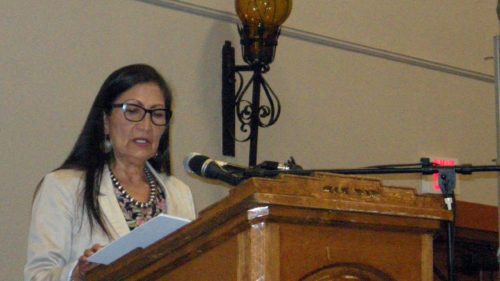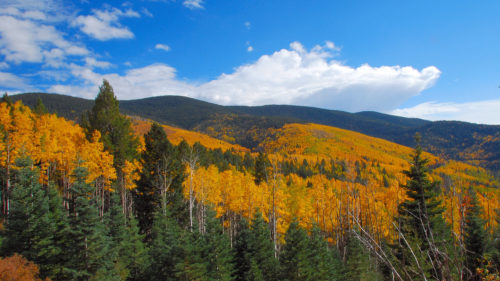WASHINGTON, D.C. — The U.S. House of Representatives on Tuesday passed the Natural Resources Management Act a public lands package that includes measures to protect wilderness within the Organ Mountains-Desert Peaks and Río Grande del Norte National Monuments.
All of New Mexico’s Representatives – Ben Ray Luján, Xochitl Torres Small, and Deb Haaland— voted in favor of the bill.
The public lands package would add more than 1.3 million acres of public land to the National Wilderness Preservation System, 621 miles of rivers to the National Wild and Scenic Rivers System, and reauthorize the Land and Water Conservation Fund. The legislation also includes dozens of other bipartisan public lands measures that would conserve some of our nation’s wildest lands and rivers.
The U.S. Senate passed the Natural Resources Management Act on February 12, 2019, and the bill now heads to President Donald Trump for his signature.
“As a veteran, I served to defend all that America stands for, and that includes our protected public lands and waters that are owned by all of us,” said Jeff Dray, an Army veteran from Las Cruces. “I want to thank New Mexico’s delegation for fighting alongside us to protect these areas for future generations to enjoy.”
Legislation to safeguard the wilderness in these two areas was first introduced by former Senator Jeff Bingaman in 2009 and then again by Senators Tom Udall and Martin Heinrich in later sessions. In 2013 and 2014, President Obama established the Río Grande del Norte and Organ Mountains-Desert Peaks National Monuments. Many of the proposed wilderness areas enjoy temporary wilderness status as Wilderness Study Areas, but only Congress can designate an official wilderness area through legislation.
Council Delegate Daniel Tso of Navajo Nation said, “These are sacred landscapes that are still used by native peoples and provide invaluable benefits. Sacred landscapes deserve protection. I am grateful to the New Mexico delegation for ushering in this legislation and recognizing the need to protect wildlife and cultural corridors.”
Both wilderness measures included in the package are decades in the making and are supported by New Mexicans across the state, including hunters and anglers, small business owners, veterans, elected officials, community and faith leaders, ranchers, and conservationists.
The bill will designate roughly 263,094 acres of wilderness within the Organ Mountains-Desert Peaks and Río Grande del Norte national monuments, and roughly 7,000 acres to be known as the Ah-Shi-Sle-Pah Wilderness. The bills were championed by Senators Udall and Heinrich, Governor Michelle Lujan Grisham, and Congressman Luján.
“Access to wilderness helps us feel connected to our greater community in the natural world. In other words, wilderness helps us unplug and unwind. As a local, independent business in Taos, we are dependent on our wild areas for the health of our community. We are so grateful to our entire New Mexico delegation for protecting wilderness in our state,” added Chris and Elena Pieper, owners of Mudd N Flood Mountain Shop in Taos.
Both wilderness bills will further boost local economies. People come to the wildest places within the national monuments to hike, hunt, fish, ride horseback, bird, camp, and more. These visits translate into real economic growth for the area. An EcoNorthwest study found that quiet recreation on Bureau of Land Management lands in New Mexico generated $173 million in 2014 and supported 1,712 jobs across the state.
“As a second-generation fly-fishing guide and sportswoman raised in Northern New Mexico, the wilderness designations proposed by the Cerros del Norte Bill will undoubtedly be good for our family business, which depends on healthy ecosystems. Of far greater importance to us though, is the cultural value that we are upholding by creating these protected areas. Wilderness is a shrinking commodity in today’s world, one that’s exceedingly difficult to get back once lost. The experiences I had growing up in this unique place, from spying my first petroglyph and golden eagle to fooling my first trout, I will cherish for the rest of my life. I want to live in a world where kids of all ages have these same opportunities, for a long time to come. This kind of legislation is absolutely the way to achieve that,” added Rita Adams, a fly fishing guide who operates in the Río Grande del Norte National Monument.
Background on the Organ Mountains-Desert Peaks Conservation Act
The Organ Mountains-Desert Peaks Conservation Act was introduced by Senators Udall and Heinrich and would designate ten wilderness areas totaling roughly 241,000 acres within the 496,330-acre national monument. The proposed wilderness would give a higher level of protection to special lands within the monument.
Hunting, livestock grazing, hiking, camping, horseback riding, firefighting, and law enforcement and border security activities would continue in the wilderness areas. The Organ Mountains-Desert Peaks National Monument contains approximately 306 bird species and 78 mammal species, including golden eagles, mule deer, javelina, cougar, ring-tail cat, and quail. The proposed wilderness will strengthen the wildlife habitat for these species and protect the watersheds that they depend on.
Background on the Cerros del Norte Conservation Act
The Cerros del Norte Conservation Act would designate two new wilderness areas – Ute Mountain (Cerro del Yuta) and Río San Antonio – within the Río Grande del Norte National Monument, totaling 21,500 acres within the 242,500-acre national monument. It was introduced by Senators Heinrich and Udall, and Congressman Luján. Governor Lujan Grisham was a co-sponsor when she was in the U.S. House of Representatives. Local community members have been working to preserve these special areas for more than 25 years.
Grazing would continue in already-permitted areas, and water rights would not be impacted under the legislation. Additionally, traditional activities like wood and piñon gathering would continue.
The proposed wilderness areas within the national monument serve as one of the world’s great avian migratory routes. These areas are also home to important game species like pronghorn and elk. Additionally, the legislation would safeguard world-class recreation opportunities already enjoyed within the national monument, including hiking, hunting, and fishing.



